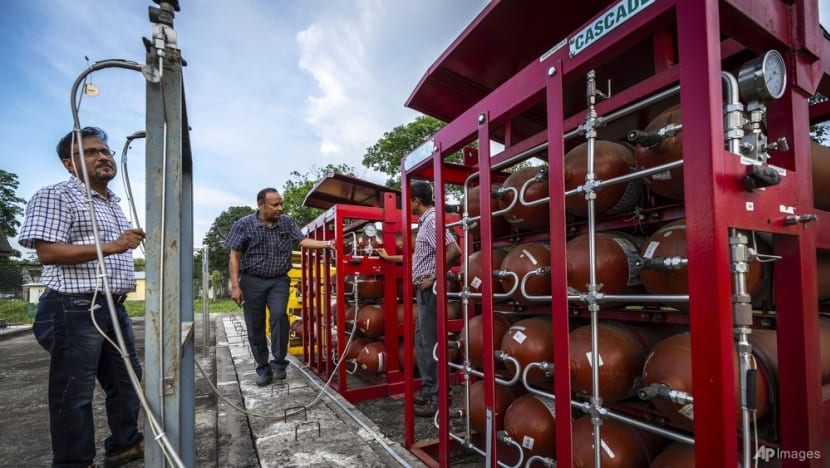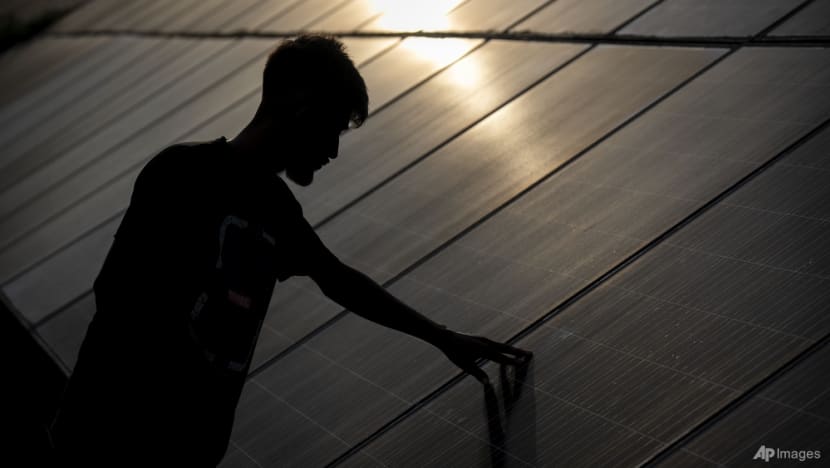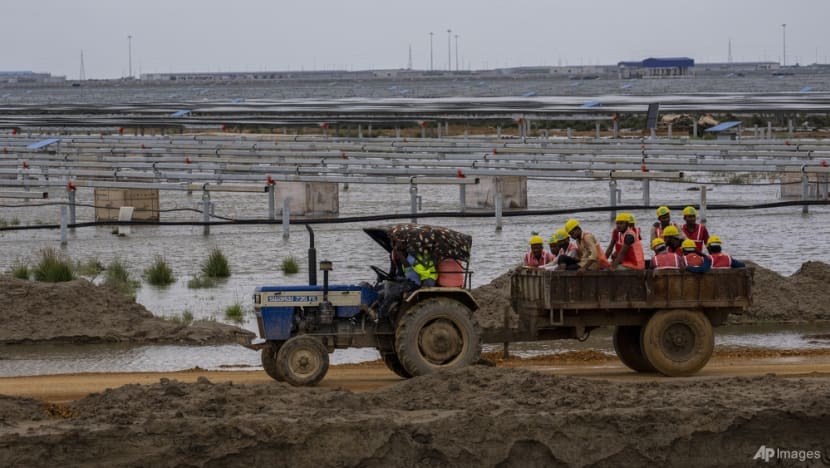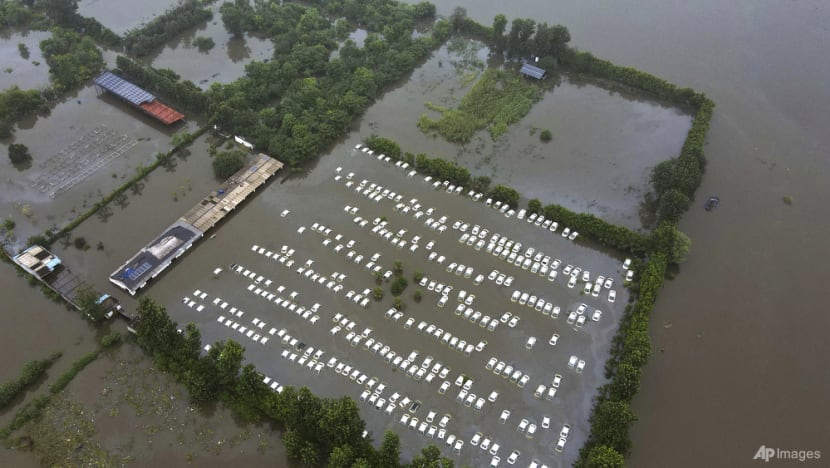India pursues green hydrogen for energy security, but funding hurdles stand in the way of its emission targets
India is increasingly focusing on green hydrogen, as part of its aim to become energy independent by 2047 and achieve net zero carbon emissions by 2070.


This audio is generated by an AI tool.
MUMBAI: India has ambitions to massively increase its use of renewable energy over the coming years, but it is facing considerable challenges in financing its green transition.
The South Asian nation is among the countries worst affected by global warming, and has been grappling with extreme weather events this year.
Record-breaking high temperatures scorched parts of the country for months, followed by unprecedented floods across the northern and western regions.
India is increasingly focusing on green hydrogen as part of its aim to become energy independent by 2047 and achieve net zero carbon emissions by 2070.
Prime Minister Narendra Modi, who attended the ongoing COP28 climate talks in Dubai for a day, has also launched a National Green Hydrogen Mission in an effort to make India a major producer of the fuel.
Green hydrogen can be used in transport – particularly for trucks and shipping – and also support industries from steelmaking to fertiliser production, which are key sectors of the Indian economy.
GREEN GAS
The gas is produced when electricity generated from renewable sources is used to split water into hydrogen and oxygen.
While it is still nascent as a fuel, the Indian government has announced plans to produce at least 5 million tonnes of green hydrogen yearly by 2030.
It has earmarked an initial budget of more than US$2.5 billion for financial incentives, research and development and building of infrastructure.
Among the players in the sector is Indian power company JSW Energy, which is building its first green hydrogen plant. The clean energy will be used for its sister company, which is one of the country's largest makers of steel.
The plant is expected to be up and running in 16 months, with a capacity of about 4,000 tonnes, making it India’s largest commercial green hydrogen project, said the firm.
“India is rightly in a very sweet spot to emerge as one of the biggest players in the green hydrogen market globally, in time to come,” JSW Energy’s director for finance Pritesh Vinay told CNA.
“I think that all the policy tailwinds that the government has come out in consultation with industries is moving in the right direction, and this can potentially become a very big opportunity.”
JSW Energy is already making plans to build a second plant which will be 20 times bigger than the first.
BENEFITS AND CHALLENGES
CRISIL Market Intelligence and Analytics senior practice leader Pranav Master, who is also director for energy and sustainability, said India’s focus on green hydrogen would improve its energy self-reliance.
“First and foremost, I think clearly from a national energy security standpoint, today, India imports a large part of its overall energy needs, and producing green hydrogen indigenously will improve its energy security,” he said.
“Second, it will help combat climate change and help meet its global commitments.”
The Indian government estimates that its green hydrogen plans could slash annual carbon dioxide emissions by 50 million metric tonnes by 2030, while saving the country over US$12 billion in fossil fuel imports.

Some of India's biggest energy companies are heavily pursuing green hydrogen solutions, but beyond producing for domestic needs, the country also wants to become a leading supplier of the fuel to other countries.
The use of green hydrogen, however, has its fair share of challenges.
It is not easy to be transported around safely, as it is the gas with the lowest density, while it is also significantly more expensive than regular fuels, according to industry insiders.
However, analysts expect the costs to drop over the next few years, as more companies like JSW Energy pursue green hydrogen as an important fuel moving forward.
PRIVATE SECTOR FINANCING
The Modi government’s race to produce 500 gigawatts of renewable energy capacity by 2030 will require the involvement of the private sector.
In October last year, Mr Modi had declared Modhera village, in India’s western state of Gujarat, the country’s first solar-powered village.
More than 1,300 solar panels there provide energy for the locals and also let them sell energy back to the grid, which makes it economically lucrative for the locals.
The central and local state governments worked together to help Modhera go solar, and the model is something the Modi government wants to replicate across India.
Start-ups such as Oorjan Cleantech are aiming to make it easier for businesses and individuals to make the green transition, by offering not just solar products but also financing solutions to help them fund the projects.
These have become popular among firms looking to bring down their costs in the long term, and households who have been drawn by government incentives to go solar.
“The government is doing a lot in terms of policies, but one of the things is that renewable energy is capital intensive,” said Oorjan Cleantech’s founder and CEO Gautam Das.
The firm has partnered with banks, financial corporations and private investors to provide loans, so far leveraging some US$120 million in five years, he said.

Green energy projects in India have so far been largely funded by non-banking financial institutions, bond markets and banks.
India currently has about 180 gigawatts of green energy capacity, and hitting that 500 gigawatt target will require more than US$300 billion in investment, according to analysts.
“Given this scale of requirement, clearly the traditional and conventional channels of financing are likely to be inadequate,” said Mr Master.
“India will need to evaluate alternate pools of capital, as well as look at innovation from a financing structure standpoint, to ensure that we have adequate financing as per needed.”
ROLE OF DEVELOPED NATIONS
Mr Modi has also long called on developed nations to help developing countries financially in the green transition, suggesting that they contribute at least 1 per cent of their GDP to climate finance.
Developing countries will need nearly US$6 trillion to implement their climate action plans by 2030, according to the United Nations.

At COP15 in 2009, developed countries had pledged to mobilise US$100 billion a year by 2020 to support climate action in less wealthy countries.
However, the Organisation for Economic Cooperation and Development (OECD) and Oxfam estimated that in 2020, only about US$83.3 billion had gone from developed to developing nations.
Mr Sumit Prasad, programme lead at the Council on Energy, Environment and Water, told CNA that developing countries are also dealing with economic challenges such as poverty, apart from the harmful impacts of climate change.
“Obviously the burden might shift to them, including India. But are we getting a commensurate amount of finance to support climate action? That is also missing,” he said.














